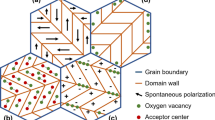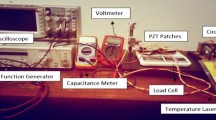Abstract
In the field of ammunition, piezoelectric ceramics are increasingly used as part of impact fuze systems. It is an urgent problem to improve the low-temperature storage and low-temperature environment adaptability of piezoelectric ceramic power supply. In order to study the dynamic mechanical and electrical response characteristics of PZT-5H at − 40 to 25 °C, the static electrical parameters of PZT-5H at different temperatures were measured, and the Hopkinson bar experiments at different temperatures and impact velocities were carried out by using the self-established low-temperature mechanical and electrical test system. The variation of resistivity and relative permittivity of PZT-5H from − 40 to 25 °C is obtained by experiment, and the relaxation time of PZT-5H is obtained according to Debye’s theory. Combined with the observation of scanning electron microscope (SEM), the influence mechanism of porosity and crack on the electrical output characteristics of piezoelectric ceramics was obtained. The mechanism of the freezing effect of piezoelectric ceramics at low temperatures is obtained through space charge theory analysis. The variation of the dynamic piezoelectric voltage constant with temperature and time in the elastic region measured by the experiment is clarified.



















Similar content being viewed by others
References
B. Jaffe, R.S. Roth, S. Marzullo, Piezoelectric properties of lead zirconate-lead titanate solid-solution ceramics. Appl. Phys. 25, 809–810 (1954)
J.E. Mckinney, C.S. Bowyer, Determination of piezoelectric properties as a function of pressure and temperature. J. Acoust. Soc. Am. 32, 56–61 (1960)
Q.M. Zhang, H. Wang, N. Kim, L.E. Cross, Direct evaluation of domain-wall and intrinsic contributions to the dielectric and piezoelectric response and their temperature dependence on lead zirconate-titanate ceramics. Appl. Phys. 75, 454–459 (1994)
B. Noheda, N. Cereceda, T. Iglesias, G. Lifante, L.W. Yong, Composition dependence of the ferroelectric–paraelectric transition in the mixed system PbZr1−xTixO3. Phys. Rev. B 51, 16388–16391 (1995)
M. W. Hooker, Properties of PZT-Based Piezoelectric Ceramics Between −150 and 250℃. NASA Langley Technical Report Server. 208708 (1998)
P.K. Panda, T.S. Kannan, J. Dubois, C. Olagnon, G. Fantozzi, Thermal shock and thermal fatigue study of ceramic materials on a newly developed ascending thermal shock test equipment. Sci. Technol. Adv. Mater. 3, 327–334 (2002)
I.N. Andryushina, L.A. Reznichenko, I.M. Shmytko, L.A. Shilkina, K.P. Andryushin, Y.I. Yurasov, S.I. Dudkina, The PZT system (PbTixZr1-xO3, 0≤x≤1.0): dielectric response of solid solutions in broad temperature (10≤T≤1000 K) and frequency (10–2≤f≤107 Hz) ranges (Part 4). Ceram. Int. 39, 3979–3986 (2013)
W.J. Xue, Study on Phase Transformation, Fracture Mechanism and Properties of Structural Ceramics at Low Temperature (Tsinghua University, Beijing, 2013).
C.F. Lan, H.C. Nie, X.F. Chen, J.X. Wang, H.L. He, Low temperature phase structure and electrical properties of dense PZT 95/5 ferroelectric ceramics. J. Inorg. Mater. 28, 502–506 (2013)
S. Anand, A. Arockiarajan, Temperature dependent ferroelectric and ferroelastic behaviour of PZT wafers. Ceram. Int. 42, 15517–15529 (2016)
W.Q. Cao, P.C. Liu, Y. Chen, R.K. Pan, Y.J. Qi, Influence of domain lag on residual polarization in ferroelectrics. Acta Physica Sin. 65, 262–268 (2016)
J. Belovickis, M. Ivanov, V. Samulionis, J. Banys, M.V. Silibin, Dielectric, ferroelectric, and piezoelectric investigation of polymer-based P(VDF-TrFE) composites. Phys. Status Solidi B 255, 1700196 (2017)
E.L. Tang, Y. Li, R.Z. Wang, Y.F. Han, Experimental research on piezoelectric ceramics activating micro-sized thermochemical battery. Int. J. Appl. Ceram. Technol. 16, 1–8 (2019)
R.Z. Wang, E.L. Tang, G.L. Yang, Dynamic piezoelectric properties of PZT-5H under shock compression. Phys. Status Solidi A 216, 1800859 (2019)
R.Z. Wang, E.L. Tang, G.L. Yang, Y.F. Han, X. Lin, Y. Li, Experimental research of electrical output characteristics of stacked PZT-5H under high-overload conditions. J. Electron. Mater. 48, 2737–2744 (2019)
R.Z. Wang, E.L. Tang, G.L. Yang, G.W. Gao, L. Wang, Research on layer-counting experimental simulation system for projectile penetrating multi-layered targets. Measurement 151, 107108 (2020)
R.Z. Wang, E.L. Tang, G.L. Yang, Y.F. Han, Experimental research on dynamic response of PZT-5H under impact load. Ceram. Int. 46, 2868–2876 (2019)
C. Flannigan, C.D. Tan, J.F. Scott, Electrical studies of Barkhausen switching noise in ferroelectric lead zirconate titanate (PZT) and BaTiO3: critical exponents and temperature-dependence. J. Phys. Condes. Matter 32, 05543 (2019)
D. Wang, Y. Fotinich, G.P. Carman, Influence of temperature on the electro-mechanical and fatigue behavior of piezoelectric ceramics. Appl. Phys. 83, 5342–5350 (1998)
Y. Mao, Y. Li, Stress wave propagation through a thin plate sandwiched between two bars. Acta. Mech. Solida Sin. 29, 239–244 (2008)
Y.F. Lu, Y. Chen, Hopkinson Bar Experiment Technology (Science Press, Beijing, 2013).
J.X. Fang, Z.W. Yin, Dielectric Physics (Science Press, Beijing, 2000).
R.Q. Han, K. Huang, Solid State Physics (Higher Education Press, Beijing, 1985).
J.D. Li, Dielectric Theory (Science Press, Beijing, 2003).
T. Zeng, G.S. Wang, X.L. Dong, H. He, X. Chen, Investigation on FR(LT)–FR(HT) phase transition and pyroelectric properties of porous Zr-rich lead zirconate titante ceramics. Mater. Sci. Eng. B 140, 5–9 (2007)
P.W. Anderson, Absence of diffusion in certain random lattices. Phys. Rev. 109, 1492–1505 (1958)
T. Mitsui, I. Tatsuzaki, E. Nakamura, An Introduction to the Physics of Ferroelectrics (Gordon and Breach Science, London, 1976).
R.M. Mcmeeking, Electrostrictive stresses near crack-like flaws. Z. Angew. Math. Phys. 40, 615–627 (1989)
M.L. Dunn, The effects of crack face boundary conditions on the fracture mechanics of piezoelectric solids. Eng. Fract. Mech. 48, 25–39 (1994)
K. Okazaki, K. Nagata, Effects of grain size and porosity on electrical and optical properties of PLZT ceramics. J. Am. Ceram. Soc. 56, 82–86 (1973)
Acknowledgements
This research was supported by the National Natural Science Foundation of China (Grant No. 11472178). Thanks to the research group in Key Laboratory of Transient Physical Mechanics and Energy Conversion Materials of Liaoning Province for their support during the experiments, especially for the efforts of Zhao Liangliang, He Zhenhui and Wang Junru in experimental measurement.
Author information
Authors and Affiliations
Corresponding authors
Ethics declarations
Conflict of interest
The authors declare that we have no conflict of interest. The data that support the findings of this study are available from the corresponding author upon reasonable request.
Rights and permissions
About this article
Cite this article
Tang, E., He, T., Han, Y. et al. Influence of temperature on the electrical characteristic parameters and dynamic electro-mechanical behaviour of PZT-5H. Eur. Phys. J. Plus 136, 364 (2021). https://doi.org/10.1140/epjp/s13360-021-01368-1
Received:
Accepted:
Published:
DOI: https://doi.org/10.1140/epjp/s13360-021-01368-1




